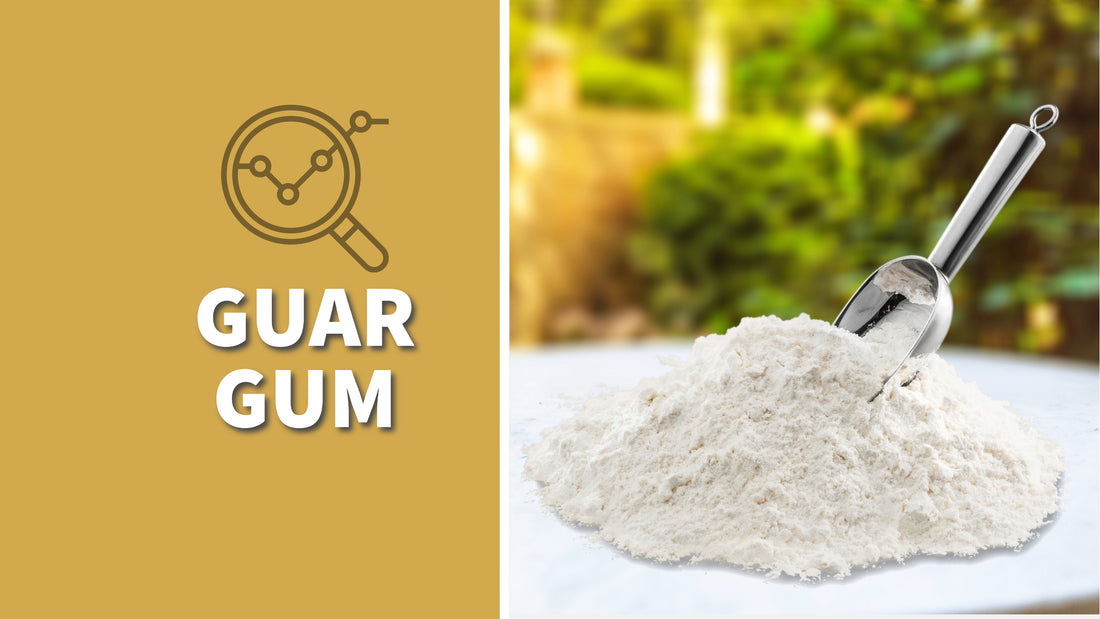
Guar Gum Guide
Guar gum, a natural polysaccharide, is extensively used as a thickening, stabilizing, and emulsifying agent in various industries. It is a galactomannan, a type of fiber extracted from the seed of the guar plant (Cyamopsis tetragonoloba), which is predominantly grown in India and Pakistan. The guar plant's seeds are composed of three parts: the germ, endosperm, and husk. Guar gum is derived from the endosperm and is known for its high viscosity and solubility in water, making it a valuable ingredient in numerous applications.
How is Guar Gum Obtained?
The process of obtaining guar gum begins with the harvesting of guar beans. Once harvested, the beans are dried and their outer pods are removed. The seeds are then split to separate the endosperm from the germ and husk. The endosperm is ground into a fine powder, which is guar gum. This process involves several steps, including roasting, differential attrition, sieving, and polishing. The final product is a white to yellowish-white, odorless powder that is readily soluble in water.
Applications of Guar Gum
Guar gum finds applications in a wide range of industries due to its thickening, stabilizing, and emulsifying properties. Some of its primary applications include:
- Food Industry: Used as a thickener in sauces, soups, and dairy products, and as a stabilizer in ice cream to prevent ice crystals. It's also used in gluten-free baking and as a fiber supplement.
- Pharmaceuticals: Employed as a binder and disintegrant in tablet formulations, and as a thickening agent in lotions and creams.
- Cosmetics: Used in shampoos and conditioners for their conditioning properties, and in lotions and creams as a thickener.
- Textile Industry: Utilized in textile processing for sizing, finishing, and printing due to its film-forming ability.
- Paper Industry: Acts as a strength additive in paper manufacturing.
- Oil and Gas Industry: Used in hydraulic fracturing as a suspending agent.
Types of Guar Gum Available in the Market
The market offers various types of guar gum, tailored to specific applications and industries. These include:
- Food Grade Guar Gum: Specifically processed for use in the food industry, meeting stringent quality and safety standards.
- Industrial Grade Guar Gum: Used in industries like paper, textile, and oil drilling, where higher viscosity and specific particle sizes are required.
- Fast Hydrating Guar Gum: A special grade used in oil drilling, known for its rapid hydration and high viscosity.
- Modified Guar Gum: Chemically modified forms of guar gum designed for specific applications, such as hydroxypropyl guar and carboxymethyl guar, which have altered properties to suit particular industrial needs.
Each type of guar gum is designed to optimize its effectiveness in its respective application, making guar gum a versatile and indispensable ingredient in various sectors.
Health Benefits of guar gum
Guar gum, derived from the guar bean, has been extensively studied for its potential health benefits. Here's an in-depth look at the evidence supporting the health benefits of guar gum:
Digestive Health and Gut Function:
Guar gum is a soluble fiber, which can aid in digestion and improve gut health(1). Soluble fibers are known to help regulate bowel movements and can alleviate constipation(2). The role of guar fiber in normalizing constipation and improving digestive health has been studied in scientific papers(3).
Blood Sugar Control:
Guar gum can slow the absorption of sugar in the bloodstream, helping to control blood sugar levels(4)(5), particularly beneficial for individuals with diabetes. Long-term intake of guar gum has shown enhanced insulin secretion and favorable effects on glycemic control(6).
Cholesterol Lowering and Lipid Improvement:
Guar gum has been shown to lower bad cholesterol (LDL) levels while maintaining good cholesterol (HDL) levels, even in long-term outcomes(7)(8). Guar gum also lowers blood lipids(9) while yielding no side effects(10).
Weight Management and Enhanced Appetite Suppression:
The fiber in guar gum can expand in the stomach, leading to a feeling of fullness, which may help in weight management(11), superior to bran(12) This may be attributed to prolonged exposure to nutrients in the intestines(13) by guar gum. This can lead to a more prolonged sensation of satiety(14) and a significant reduction in appetite(15).
Cardiovascular Health and Blood Pressure Reduction:
Some studies suggest that guar gum can help lower blood pressure long term(16) and even in the absence of any changes in body weight(17), contributing to overall heart health. This was compared in high-quality studies with placebo controls(18). By modulating the rate of nutrient release, guar gum can also help modulate blood pressure and reduce hypotension or fall of blood pressure(19)(20). These results may be magnified in the presence of whey protein(21), a key ingredient in our products.
Gastrointestinal Health and Gut Microbiome:
Guar gum can positively affect the gut microbiota(22), promoting the growth of beneficial bacteria(23).
Anti-Inflammatory Properties:
Guar gum may exhibit anti-inflammatory properties, studied in cell and animal models(24)(25), which can be beneficial in managing various chronic diseases.
Gluten-Free Diet Support:
Guar gum is a popular ingredient in gluten-free products, providing texture and consistency similar to gluten-containing foods(26)(27).
What Can I Do at Home with Guar Gum?
Guar gum, with its thickening and stabilizing properties, can be a versatile ingredient in your home kitchen. Here's how you can use it in various recipes:
- Gluten-Free Baking: Use about 1/4 to 1/2 teaspoon of guar gum per cup of flour for cakes and bread. Guar gum provides the necessary elasticity and fluffiness to gluten-free baked goods.
- Thickening Soups and Sauces: Start with 1/8 teaspoon of guar gum to thicken a cup of liquid. Sprinkle it in and whisk continuously to avoid clumping. Adjust the quantity as needed to achieve the desired thickness.
- Homemade Ice Cream: For a quart of ice cream mixture, use 1/4 to 1/2 teaspoon of guar gum. It prevents the formation of ice crystals, resulting in smoother and creamier ice cream.
- Dairy Products: To thicken homemade yogurt, use about 1/4 teaspoon of guar gum per cup of milk. For dairy-free spreads and dips, adjust the amount based on the desired consistency.
- Salad Dressings: Use a pinch (about 1/8 teaspoon) of guar gum for a cup of salad dressing to emulsify and stabilize the mixture, keeping the oil and vinegar from separating.
Remember, a little goes a long way with guar gum due to its high thickening power. Start with a small amount and gradually increase if needed, ensuring to mix thoroughly to prevent clumps.
FAQ about guar gum
Is Guar Gum Safe?
Yes, guar gum is generally recognized as safe (GRAS) by the FDA after a body of scientific testing. However, like any food additive, it should be consumed in moderation.
How is Guar Gum Digested in Our Body?
Guar gum is a soluble fiber. It is not digested in the small intestine but is partially broken down in the large intestine, aiding in digestion and promoting gut health.
Why is Guar Gum Added to Food Products?
Guar gum is added to food products as a thickener, stabilizer, and emulsifier. It improves the texture, consistency, and shelf life of food products.
Is Guar Gum Suitable for Diabetics?
Yes, guar gum is suitable for diabetics. It is low in calories and can help in managing blood sugar levels due to its high fiber content.
How Do I Use Guar Gum?
Use guar gum sparingly as it is a powerful thickener. Typically, a small amount (around 1/4 to 1/2 teaspoon) is enough for most recipes.
How Much Guar Gum Can I Eat Per Day?
While there's no specific recommended daily intake, it's important to use guar gum in moderation. Excessive consumption can lead to gastrointestinal issues.
Is Guar Gum Natural?
Yes, guar gum is a natural product derived from the seeds of the guar plant. It is processed into a powder form for use in various applications
